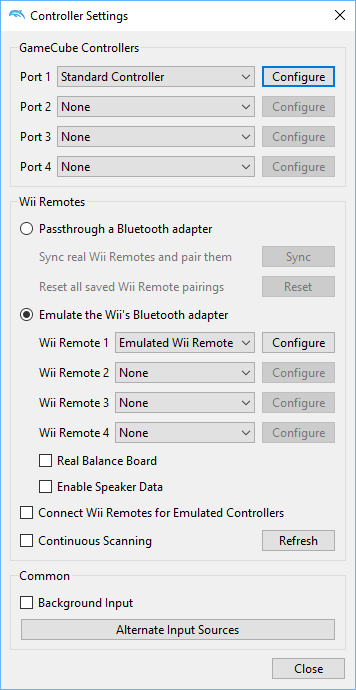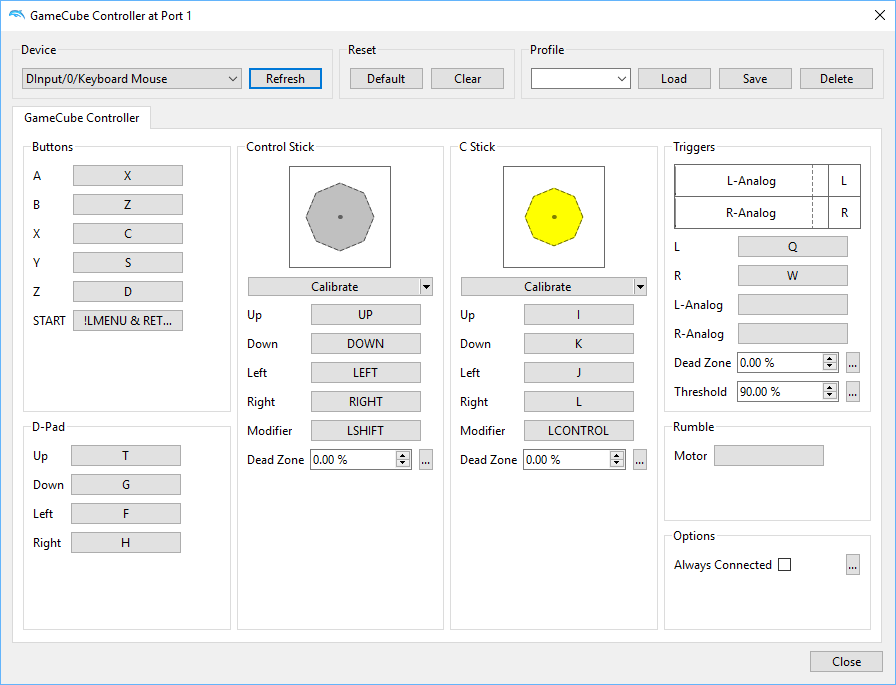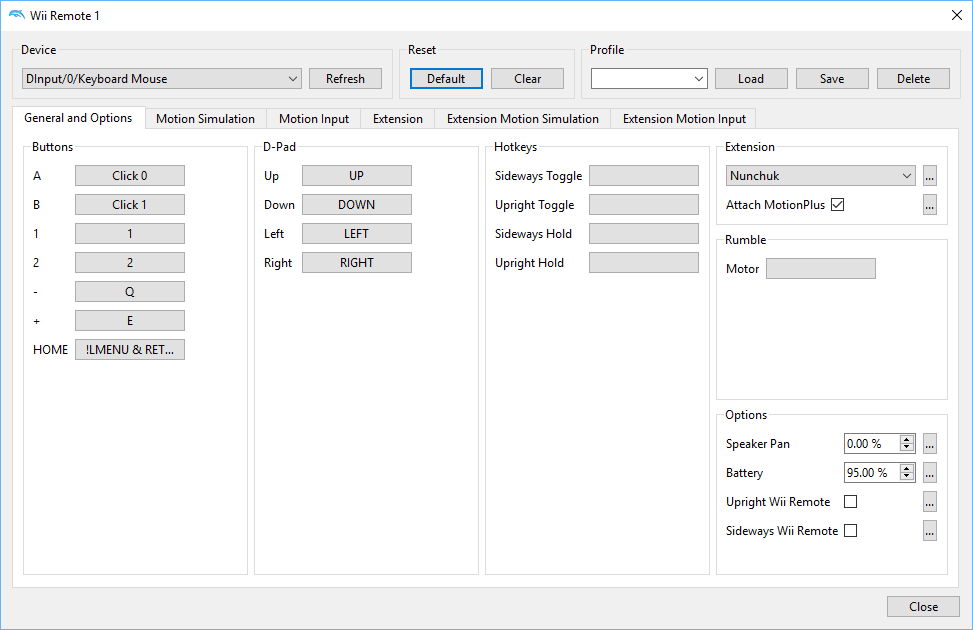Configuring Controllers
This page explains how to configure controllers in Dolphin, assuming the controller is connected and working with your system. If you need help, or want game-specific configurations, see the forums.
GameCube controller
First, click the "Controllers" button.

In this screen, you can set what is plugged into the various emulated ports. If you wish to use more than one GCpad, make sure you set the correct number in the top under "GameCube Controllers".
After you select what do you want to use, click on "Configure" for one of the GameCube controllers.

Choose any device that is connected to your PC in the Device dropdown, and set the buttons and axes to your liking.
- Left click a slot to detect input, then press a button or axes on your selected controller to save it to that slot.
- Middle click a slot to clear it of inputs.
- Right click a slot to show more input options.
If you controller supports it, "Rumble" will allow your controller to experience the GameCube's rumble functionality. Once in the window, click on the motor pattern you wish to use (sine, cosine, etc), and press "Select" to apply it. If you wish to add a second pattern, with your existing pattern still there, click another pattern and press "|OR". Hit OK to accept the changes and exit the window.
Background input lets you use the controller even if Dolphin isn't in focus.
"Radius" limits the radius of the joystick input. Since the GameCube controller does not use 100% of its radius, a radius of 70-75 is appropriate for most controllers. Those using an unofficial GameCube adapter should set the radius to 100.
"Profile" allows you to save/load input configs.
After setting up everything that you want, click "OK" and the changes will save.
Using an Official GameCube Controller Adapter for Wii U
See: How to use the Official GameCube Controller Adapter for Wii U in Dolphin
Wii Remote

Wii Remote settings are also found in the Controllers panel. Dolphin can use both real and emulated Wii Remotes.
Real Wii Remote
Select Real Remote in the dropdown for a Wii Remote slot. Dolphin supports up to 4 Real Wii Remotes at once, along with any peripherals you have attached to them.
- To connect a Real Wii Remote, press Refresh then press the "1" and "2" buttons on your Wii Remote simultaneously. If Continuous Scanning is enabled, there is no need to press refresh every time: just press the "1" and "2" buttons simultaneously after the game is running or when the Wii Remote window is open. Real Wii Remote connectivity will only work if one of the Wii Remotes is set to "Real Wii Remote" or "Hybrid Wii Remote". RVL-CNT-01-TR Wii Remote Pluses do not work with this method, see the Wii Remote Plus (RVL-CNT-01-TR) Connection Guide.
Continuous Scanning allows you to connect a Wii Remote without having to open the Wii Remote window and press refresh every time. As long as a game is running or the Wii Remote configuration window is up, just press "1" and "2" on your wiimote simultaneously and it will connect. This option will only work if a Real Wii Remote is selected in one of the wiimote slots.
The Wii Remote may be disconnected after a brief of inactivity within the game emulation. Tools -> Connect Wii Remotes -> Connect Wii Remote # or a hotkey corresponding to it will renew the connection.
Dolphin does not automatically turn off Wii Remotes as the Wii will. Remember to turn off controllers on your own to save battery power, simply by holding the power button on Wii Remote for a second as you would to turn off the Wii. It will also tell Dolphin that it's disconnected instead of stopping the game emulation.
Emulated Wii Remote

Emulated remote works in the same way as the GCpad settings. Choose any device that is connected to your PC in the Device dropdown, and set the buttons and axes to your liking.
- Left click a slot to detect input, then press a button or axes on your selected controller to save it to that slot.
- Middle click a slot to clear it of inputs.
- Right click a slot to show more input options.
Extension Allows you to add an emulated nunchuk, guitar, or other wiimote peripheral. Select the extension you want to emulate in the dropdown, and press configure to open a window with slots just like the emulated wiimote window. Select buttons and axes as you wish, and press OK to save.
Background input lets you use the controller even if Dolphin isn't in focus.
Sideways Wii Remote changes the emulated wiimote controls to allow you to play games as though the wiimote is sideways, without actually changing your controls. It is useful for games such as New Super Mario Bros. Wii that are designed for it.
Upright Wii Remote alters the base swinging and tilting orientation of the emulated wiimote to the upright position.
Speaker Pan allows you to shift the emulated wiimote audio to the left or the right on your system speakers, if "Enable Speaker Data" is checked. -127 is left, 0 is centered, and +127 is right.
If you controller supports it, "Rumble" will allow your controller to experience the Wii Remote's rumble functionality. Once in the window, click on the motor pattern you wish to use (sine, cosine, etc), and press "Select" to apply it. If you wish to add a second pattern, with your existing pattern still there, click another pattern and press "|OR". Hit OK to accept the changes and exit the window.
"Profile" allows you to save/load input configs.
After setting up everything that you want, click "OK" and the changes will save.
General Settings
These settings apply to both emulated and real wiimotes.
Sensor Bar Position, IR Sensitivity, Speaker Volume, and Wii Remote Motor are duplicates of Wii settings. They do exactly what they say they do, and work exactly like the same settings on the Wii itself.
If Enable Speaker Data controls whether the wiimote speaker can produce sound. When using a Real Wii Remote, the audio will come out of the wii remotes' speakers; with emulated wiimotes, it will come out of the system speakers. Some games, like Metroid Prime 3, have lag issues when Enable Speaker Data is enabled on some systems.